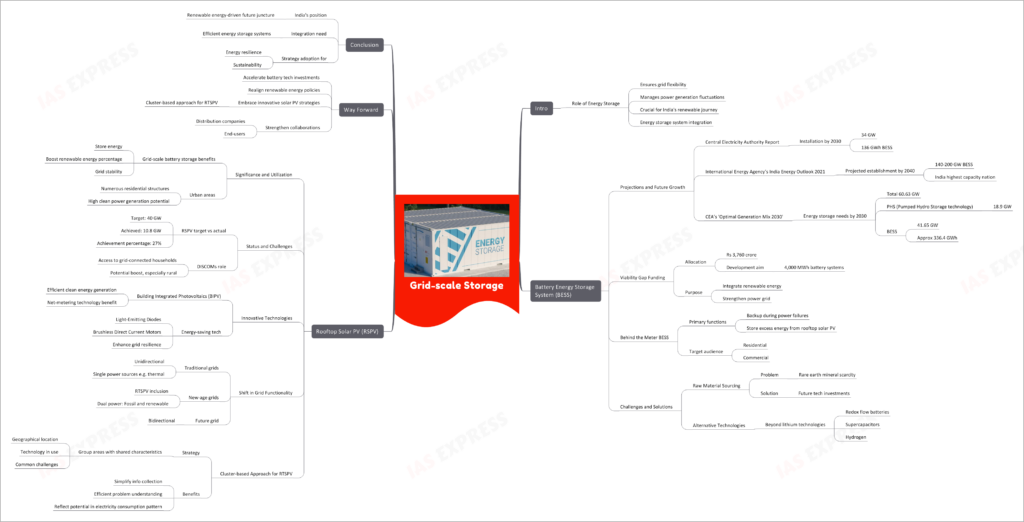Grid-scale Storage- How can it help our Renewable Energy Transition?
From Current Affairs Notes for UPSC » Editorials & In-depths » This topic
IAS EXPRESS Vs UPSC Prelims 2024: 85+ questions reflected
Energy storage plays a pivotal role in ensuring the flexibility of the power grid amidst fluctuations in power generation. As India makes strides in its renewable energy journey, the integration of energy storage systems is becoming indispensable.

Battery Energy Storage System (BESS)
Projections and Future Growth
- Central Electricity Authority Report:
- By 2030, an expected installation of 34 GW (or 136 GWh) of BESS in India.
- International Energy Agency’s India Energy Outlook 2021:
- A projected establishment of 140-200 GW of battery energy storage capacity by 2040, making India the country with the highest capacity.
- CEA’s ‘Optimal Generation Mix 2030’:
- By 2030, India might need 60.63 GW of energy storage capacity comprising:
- 18.9 GW from pumped hydro storage technology (PHS).
- 41.65 GW from BESS, approximately 336.4 GWh in total.
- By 2030, India might need 60.63 GW of energy storage capacity comprising:
Viability Gap Funding
- An allocation of Rs 3,760 crore for developing 4,000 MWh of battery storage systems.
- This funding aims to bolster the integration of renewable energy into the power grid.
Behind the Meter BESS
- Primarily serves to:
- Offer backup during power failures.
- Store excess energy from rooftop solar photovoltaic (PV) generation.
- Targets both residential and commercial entities.
Challenges and Solutions
- Raw Material Sourcing:
- Difficulties in obtaining rare earth minerals, crucial for battery technologies, as they are scarce in India.
- Alternative Technologies:
- Future investments to explore technologies beyond lithium, like redox flow batteries, supercapacitors, and hydrogen.
Rooftop Solar PV (RSPV)
Significance and Utilization
- Grid-scale battery energy storage can store energy, enabling a higher percentage of renewable energy while also stabilizing the grid.
- Urban areas consist of numerous residential structures that can generate substantial clean power.
Status and Challenges
- Despite setting a target of 40 GW for rooftop solar PV, the current capacity stands at just 10.8 GW, marking only 27% of the goal achieved.
- DISCOMs, having access to most grid-connected households, can galvanize the potential for rooftop solar PV, especially in rural regions.
Innovative Technologies
- Building Integrated Photovoltaics (BIPV):
- Capable of efficient operation with increased clean energy generation from buildings, resulting in more energy entering the grid via net-metering technology.
- Light-Emitting Diodes and Brushless Direct Current Motors:
- Aims to minimize energy consumption, thereby enhancing grid resilience.
Shift in Grid Functionality
- Traditionally, power grids were unidirectional, with power coming from single sources like thermal plants.
- With the inclusion of RTSPV, grids can now accept power from both fossil fuels and renewable sources.
- The future envisages a shift to a bidirectional grid.
Cluster-based Approach for RTSPV
- A strategy based on grouping areas with shared characteristics, for instance, geographical location, technology in use, and common challenges.
- Simplifies information collection and problem understanding, resulting in more resource-efficient solutions.
- The electricity consumption pattern within a cluster reflects the potential of RTSPV systems in such regions to cut down energy-related expenses.
Way Forward
To foster a sustainable energy future, India must:
- Accelerate investments in emerging battery technologies.
- Realign policies to ensure they resonate with the interests of all stakeholders in the renewable energy sector.
- Embrace innovative solar PV technologies and strategies, including the cluster-based approach for RTSPV.
- Foster collaborations between different stakeholders, especially between distribution companies and end-users.
Conclusion
India stands at a pivotal juncture in its journey towards a renewable energy-driven future. As the nation gravitates towards cleaner energy sources, integrating efficient energy storage systems and adopting innovative strategies will be instrumental in achieving energy resilience and sustainability.
Practice Question for Mains
Why does India’s renewable energy transition need grid-scale storage solutions? How can this be achieved? (250 words)
If you like this post, please share your feedback in the comments section below so that we will upload more posts like this.

